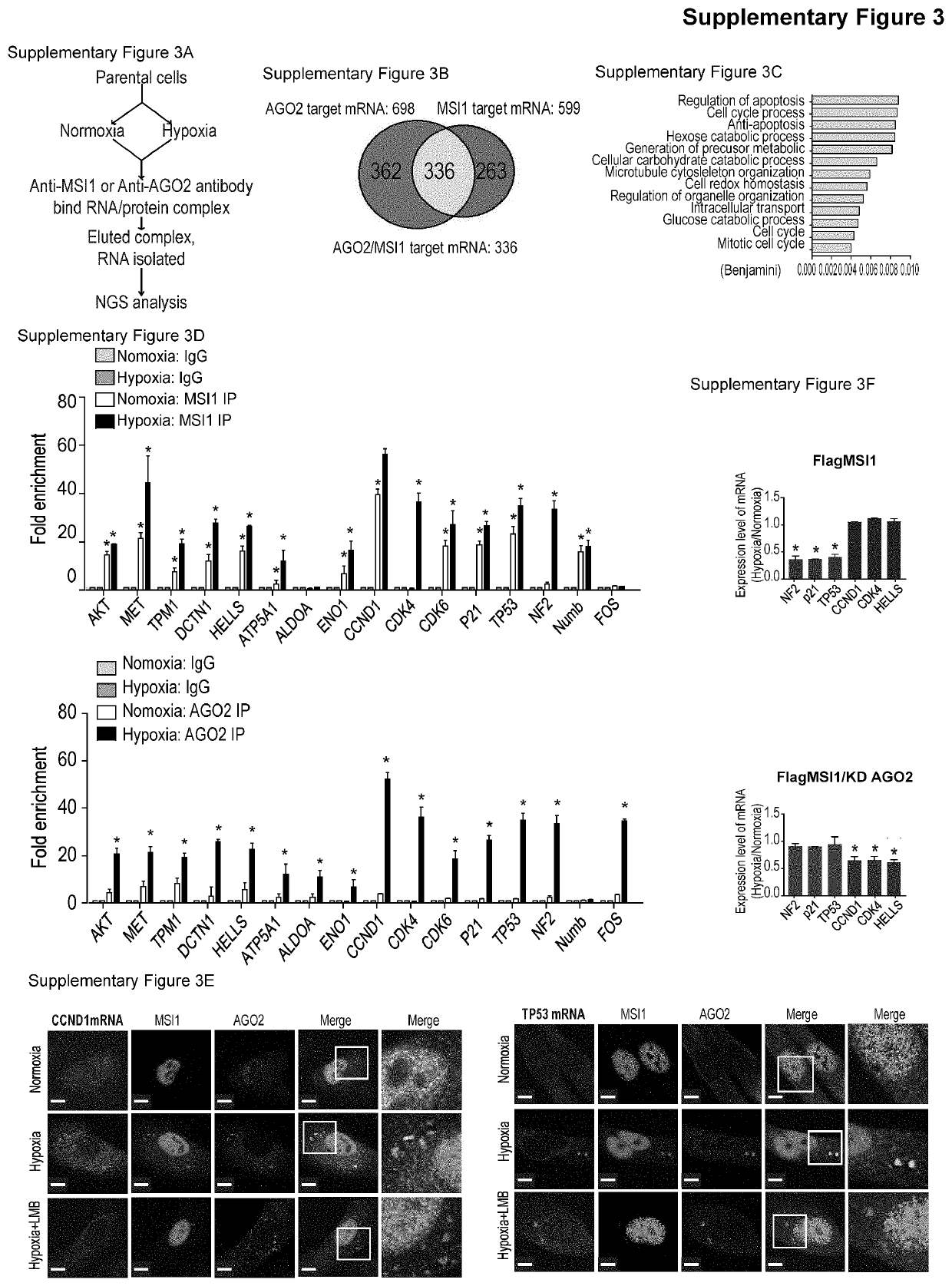Method for blocking stress-induced tumor progression
a tumor progression and stress-induced technology, applied in the direction of peptides/protein ingredients, drug compositions, peptides, etc., can solve the problems of unclear mechanisms by which ago2 coordinates the translation rate of specific targets in response to stress in malignant progression, and achieves enhanced tumor proliferation, preventing their rapid degradation, and enhancing tumor growth
- Summary
- Abstract
- Description
- Claims
- Application Information
AI Technical Summary
Benefits of technology
Problems solved by technology
Method used
Image
Examples
example 1
Translocation of MSI1 is Essential for its Pro-Oncogenic Effects Under Stress
[0098]Overexpression of MSI1 has been reported in several tumor tissues9,10,13-17. We first examined the correlation between MSI1 and tumor progression by immunohistochemical (IHC) staining on a small cohort of glioma patient samples. We found that high levels of MSI1 expression positively correlated with severe cancer malignancy and recurrence (FIG. 9A and FIG. 9B) and also observed a significant proportion of MSI1 proteins in the cytosol in recurrent glioma samples compared with the non-recurrent samples (FIG. 1A). We asked whether MSI1 could be dynamically regulated in response to hypoxic or chemotherapeutic agents. To address this possibility, we first exposed 05 MG cells, human glial cells derived from a patient with glioblastoma (GBM), to hypoxic treatment. Cell exposure to hypoxia did not affect the total level of MSI1, but increased MSI1 levels in the cytosolic compartment (FIG. 1B and FIG. 1C). Sim...
example 2
MSI1 Directly Binds AGO2 to Modulate the Expression of its Target mRNAs
[0100]To address the underlying molecular mechanisms by which MSI1 shuttling promotes stress-induced tumor progression, we characterized MSI1 interacting proteins by mass spectrometry analysis. The Flag-tagged MSI1 protein complex in the cytosolic fraction of 05 MG cells under normoxia or hypoxia was purified and characterized25 (FIG. 2A and FIG. 10A). Among the interacting proteins that are related to stress response (FIG. 10B), we found that hypoxic stress significantly enhanced the recruitment of AGO2 to cytosolic MSI1 in GBM and PDAC cancer cells (FIG. 2B and FIGS. 11C and 11D). In vitro binding assay confirmed the direct interaction between recombinant MSI1 and AGO2 (FIG. 2C). Fluorescence Resonance Energy Transfer (FRET) microscopy (FIG. 2D and FIG. 10F), and confocal microscopy in cisplatin-treated (FIG. 10G) and hypoxia-treated (FIG. 10H) cells confirmed the stress-induced interaction between MSI1 and AGO...
example 3
Binding to a Specific Location on its Targets Mediates Distinct mRNA Fates
[0101]To decipher the molecular mechanisms by which MSI1 / AGO2 complex regulates mRNA stability, we carried out RIP experiments in control. MSI1- and AGO2-knockdown cells under normoxia and hypoxia. Interestingly, MSI1 bound to its mRNA targets under normal and hypoxic conditions while AGO2 bound to its targets only under hypoxia (FIG. 3A). Knockdown of AGO2 did not affect MSI1 binding to its mRNA targets whereas knockdown of MSI1 hampered AGO2 recruitment (FIG. 3A), suggesting a MSI1-dependent recruitment of AGO2 to mRNA targets under hypoxia. We next investigated the impact of MSI1 shuttling on MSI1-mRNA complex formation. To do so, we performed RIP experiments with the cytosolic and nuclear fractions of cells overexpressing MSI1-wt cultured under normoxia and hypoxia conditions. We showed that under normoxia, MSI1-mRNA complexes were in the nucleus and that upon hypoxia, they were enriched in the cytosol (FI...
PUM
| Property | Measurement | Unit |
|---|---|---|
| volume | aaaaa | aaaaa |
| volume | aaaaa | aaaaa |
| total volume | aaaaa | aaaaa |
Abstract
Description
Claims
Application Information
 Login to View More
Login to View More - R&D
- Intellectual Property
- Life Sciences
- Materials
- Tech Scout
- Unparalleled Data Quality
- Higher Quality Content
- 60% Fewer Hallucinations
Browse by: Latest US Patents, China's latest patents, Technical Efficacy Thesaurus, Application Domain, Technology Topic, Popular Technical Reports.
© 2025 PatSnap. All rights reserved.Legal|Privacy policy|Modern Slavery Act Transparency Statement|Sitemap|About US| Contact US: help@patsnap.com



